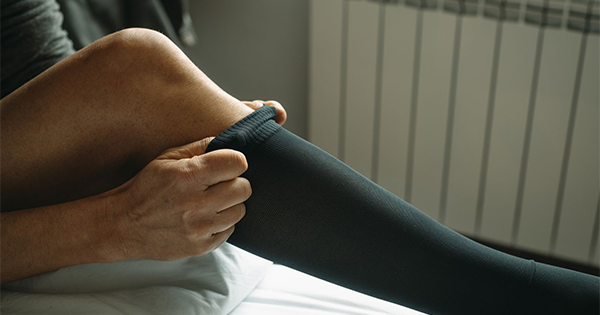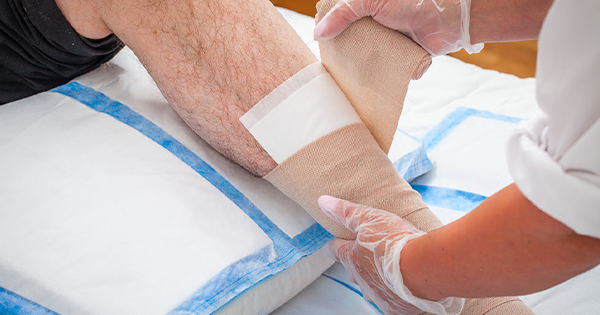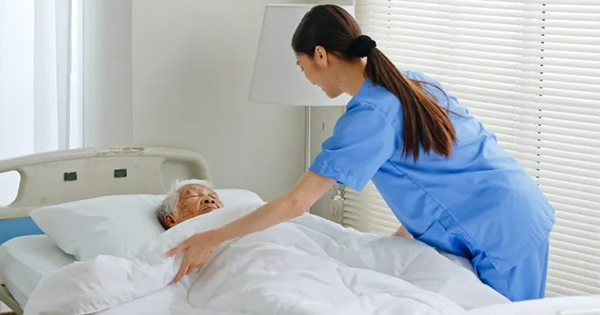The local geographical footprint
The Lytham District Nursing Team covers five GP surgeries over a large geographical footprint, including Blackpool, Thornton-Cleveleys, Poulton-le-Fylde, Garstang, Great Eccleston, Over Wyre, Lytham St Annes, Kirkham, Wesham and the surrounding villages, consisting of a population of 352,000 (Blackpool Teaching Hospitals NHS Foundation Trust, 2024). The team are responsible for Lytham St Annes and the surrounding areas of Warton and Freckleton. Lytham St Annes, with a population of 42,695, is a popular retirement area; the 2021 census concluded the town had a median age of 54 years, making it one of the English towns with an older population (City Population, 2021). With an ageing population, the district nursing team manage a range of patients with growing complexities of health requirements, including the management of venous leg ulceration (VLU). It has been reported that the risk of VLU increases with age, with 22% of individuals developing their first VLU by the age of 40, and 13% by the age of 30, negatively affecting their ability to work and participate in social activities (Alavi et al, 2016).
The clinical issue requiring change
Following a local review of district nursing services, it was identified that staff did not perceive lower limb wound care to be a priority. Vascular assessments were repeatedly deferred, and follow-up compression visits became irregular due to limited band 4 and 5 nurse capacity. Since August 2023, there had been limited capacity within the team, with 12 posts not filled due to maternity leave, long-term sickness and job vacancies. This led to team members frequently working an extra 200-300+ minutes, equating to 18,000 minutes or 300 hours per month. This results in a poor work/life balance, decreased morale, increased sickness levels, staff absences and reports of burnout and stress-related ill health. To assist with workload planning, Malinko, a scheduling software program, is used to allocate work, where each clinical intervention is set a prescribed number of minutes for completion. For example, a visit to apply bilateral compression, including the clinical intervention, documentation and travel time, would be allocated 70 minutes. With an growing workload, reduced financial status for the trust and increasing complexities of care interventions, the district nursing team were struggling to undertake lower limb assessments and follow-up appointments in a timely manner.
It was essential that a solution was implemented using available resources to reduce the caseload, effectively utilise skill mix and improve patient care while improving wound healing rates. It was agreed to use compression hosiery instead of compression bandages, where appropriate. Regarding healing rates, Ashby et al (2013) determined there was no significant difference between the two treatment options reporting the advantages and disadvantages of the two systems. Compared to hosiery kits, bandages tend to be bulkier and more expensive over the duration of treatment. Still, they can be tolerated by more patients, as some participants in research trials found hosiery kits uncomfortable.
A mixed-methods study comparing three compression systems (four-layer and two-layer compression bandages, and two-layer compression hosiery) indicated that hosiery was preferred as the primary treatment (Oates and Adderley, 2019). This study assessed the proportion and rates of healing, pain, and quality of life, concluding that low-strength compression hosiery outperformed compression bandages (Oates and Adderley, 2019).
Furthermore, a randomised controlled trial (Taradaj et al, 2009) found that compression hosiery was more effective than compression bandages in healing lower leg venous ulcers, resulting in lower costs – an essential factor for healthcare providers when making first-line treatment decisions (Ashby, 2014). Likewise, a quantitative study by Brizzio et al (2010) reported faster ulcer size reduction with compression hosiery . Atkin et al (2016) also argued that hosiery has a low profile that does not restrict patients’ choice of footwear or clothing, whereas compression bandages can restrict footwear and clothing choices.
Compression hosiery had not previously been considered a treatment option due to a lack of training and, therefore, a lack of clarity and understanding regarding the multitude of available hosiery products.
A quality improvement program was developed to optimise the use of appropriate compression hosiery for leg ulcer management. The objectives were to:
- Increase the appropriate use of compression hosiery to 75% across the locality.
- Reduce staff workload.
- Ensure that vascular assessments and Doppler tests were completed within the project period.
The Quality Improvement Project (QiP)
The QiP involved implementing an enhanced referral process for patients with leg ulcers, ensuring they received timely vascular assessments and senior reviews. Scheduled to run from August 2023 to June 2024, the QiP included immediate alerts to senior nurses for newly admitted patients with leg ulcers, facilitating prompt lower limb assessments. The second element of the QiP was a leg ulcer caseload review, identifying patients in three sub-categories:
- Patients awaiting assessment and Doppler.
- Patients already in compression bandaging.
- Patients who were already wearing compression hosiery.
Following the caseload review, a vascular leg ulcer assessment and Doppler were scheduled and completed for all patients who had not yet had a Doppler to determine if they were eligible for compression therapy. The overall aim was to provide full compression hosiery. However, it was noted that some people cannot tolerate full compression due to comfort issues or find it difficult to apply and remove hosiery safely. Training was offered to relatives and carers for patients with reduced dexterity to allow them to assist. This partnership was key to supporting adherence with treatment and empowering patients.
Patients already in compression bandages who presented with minimal oedema, smaller wounds and levels of exudate contained within a dressing were placed into hosiery.
Providing education and skills development for all staff was integral to the new processes. All team members attended education days and were assessed by senior staff to determine whether they were confident and competent enough to apply for the hosiery. Following product range presentations from hosiery companies, a decision was made to standardise hosiery across the team using URGO medical compression hosiery.
Results of the QiP
The QiP project began in August 2023 with a caseload of 64 patients. Five patients had previously received vascular assessments and Doppler tests and wore compression bandages. The remaining 59 patients had not received a vascular assessment or Doppler. In September 2023, patients without red flags, as identified by the National Wound Care Strategy (NWCS, 2024), were provided with 20mmHg of compression. Following vascular assessment, this was increased to liners and hosiery, giving up to 40mmHg of compression. This intervention led to the complete healing of ulcers in 15 patients, who transitioned to maintenance hosiery, which was variable and dependent on tolerance levels.
By November 2023, all 64 patients had undergone a vascular assessment and Doppler. Of these patients, 13 were deemed unsuitable for compression therapy due to vascular or arterial issues or malignant wound aetiology. Eight patients were placed in compression bandaging because they did not meet the criteria for compression hosiery, either because their wounds exceeded 10 cm in length or width (NWCS, 2024) or because they had highly exuding wounds requiring extra absorbent dressings. By the end of February 2024:
- No patients were waiting for a Doppler.
- Thirty patients had healed and were wearing maintenance hosiery.
- Twenty patients were unsuitable for any compression therapy.
- Six patients remained in bandages.
- Eight patients had active wounds and were wearing hosiery.
- The objectives of the QiP initiative, which commenced in August 2023, were successfully met earlier than anticipated, and the project concluded in February 2024.
Discussion
Promoting consistency and continuity of care in lower limb care aligns with the Trust’s 5-year strategy plan to reduce the risk of lower limb amputations, which is particularly significant as Blackpool has the highest rate of foot amputations in the UK. According to Hospital Episode Statistics (HES), inpatient data on admissions to NHS hospitals in England from April 2006 to March 2018 revealed 47,249 major lower limb amputations, 48% of which were associated with diabetes (Baker, 2023). This corresponds to an annual peripheral arterial disease (PAD)-related amputation rate of 11 per 100,000 among the population aged ≥25 years (Maheswaran et al, 2024). The project successfully increased healing rates and facilitated the timely identification of potential vascular issues, leading to appropriate referrals [Figure 1]. While the level of compression provided by bandages can vary depending on the abilities of the staff member applying them, hosiery can ensure a more consistent level of compression, thus optimizing healing. Local experience has demonstrated that Urgo Altipress (40mmHg) and Altiform (below 40mmHg) compression hosiery have proven to be acceptable to patients, who report that it is comfortable to wear and easy to apply and remove.
Feedback received from a patient who had been on the caseload for 3.5 years and was commenced on 40mmHg hosiery in August 2023 went on to heal within 4 months, demonstrating clinical effectiveness:
“I had a leg ulcer for 3.5 years and have tried many different treatments, including compression bandaging. It was driving me mad, and I was desperate for it to heal. The nurses recommended the compression stockings to me and have worked with me to support me to become confident to put my own hosiery on. My wound has healed and I now use what they call maintenance hosiery which is great. I find it comfortable and supportive, and it just looks like I’m wearing normal stockings, so I don’t feel embarrassed when I go out and see my friends. I am hoping I don’t get anymore wounds and I know that wearing the stocking will reduce the risk of this. I’m so glad the nurses were able to get the stockings for me, as I feel I now have my life back. Thank you so much.”
High-quality compression hosiery designed to support wound healing contributes to improving patients’ quality of life. The hosiery range available provides cost-effective products suitable for all our patients. The district nursing team found the Urgo Measure & Go website a useful tool for use in day-to-day practice, assisting staff with selecting the appropriate product and increasing confidence in their interventions.
Throughout the project, there was a noticeable reduction in patients returning to the caseload with a deterioration of their leg ulcer due to ongoing support with hosiery prior, regular follow-up compression visits from health care assistants (Band 3) helped to support patients and increased concordance with maintenance hosiery. An evaluation of staff time highlighted that the team saved 15,840 minutes/264 hours/35.2 days of nursing time per month [Figure 2], equating to an average financial saving of £5,944.75 in nursing time and £1,066 in dressings per month. Informal feedback from staff indicated that they felt their workload had decreased, providing them greater variety in their daily activities. This was because compression visits, which previously occupied a significant portion of their shifts, had been reduced. As a result, their job satisfaction increased, and they reported feeling less stressed and burnt out.
Sustainability is a key priority for the NHS. In 2020, the NHS launched its Greener NHS campaign (NHS England 2020), which included a national consultation with patients and staff and widespread engagement across the organization. This effort culminated in the publication of Delivering a ‘Net Zero’ National Health Service in 2022, which established two primary targets:
- Achieving net zero by 2040 for emissions directly controlled by the NHS
- Achieving net zero by 2045 for emissions the NHS can influence (NHS England, 2022)
The Health and Care Act 2022 further emphasises the NHS’s commitment to addressing climate change by imposing new responsibilities on NHS England, trusts, foundation trusts and integrated care boards to meet statutory emissions and environmental targets.
This QiP aligns with the Trust’s green and sustainable agenda by reducing carbon emissions by purchasing hosiery products manufactured in Britain and through the decreased need for patient and staff travel through the minimisation of visits required. The promotion of hosiery use also reduces the number of disposed bandages.
In their Cochrane review, de Moraes Silva et al (2024) concluded that compression bandages or hosiery can help heal most venous ulcers. Additionally, they found that continuing compression therapy may reduce the recurrence of ulcers. Therefore, increased adherence to hosiery can help decrease the incidence of leg ulcers in the population.
It is widely recognized that NHS resources are limited, and the community nursing workforce is significantly depleted (Baker, 2023), making it challenging to provide timely and effective care. However, when healthcare professionals reflect on and review current service provisions, they can identify opportunities for transformational improvements. By utilizing the available mix of skills, supporting staff development, and incorporating evidence-based, cost-effective treatments, healthcare services can ultimately reduce unwarranted variation and optimize patient outcomes.
Conclusion
The Quality Improvement Programme (QiP) successfully addressed critical challenges in lower limb care management within the NHS Trust, aligning with the organisations 5-year strategy plan to reduce lower limb amputations. By optimising the use of compression hosiery, QiP improved patient outcomes, reduced staff workload, and achieved substantial financial savings. The programme also demonstrated environmental benefits, supporting the Trust’s green agenda. Continuous improvement in the referral process and training staff to effectively use hosiery were key factors in enhancing the quality and consistency of care. The positive feedback from patients and staff reflects the overall effectiveness of this approach.





